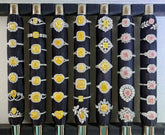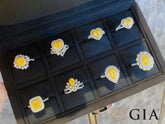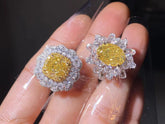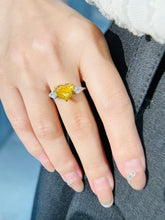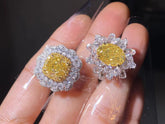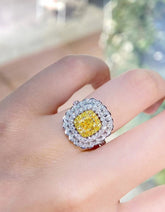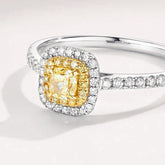Nearly 20% of diamonds on the market are laboratory-grown! Luxury brands and celebrities are deeply involved.
With the increasing consumer awareness, non-mined gemstones are becoming more and more popular. It is estimated that laboratory-grown diamonds account for nearly 20% of the total global diamond jewelry market. Last year, the global sales of laboratory-grown diamonds surged by nearly 40%, and major brands like Pandora and Swarovski have also begun to be popular. However, some experts warn that the value of these diamonds is not as high as natural diamonds.

【Vrai showroom in Yorkville, Toronto, displaying a laboratory-grown diamond. Image source: CBC】
When Evelyn Schaffer first saw her engagement ring, she was stunned. It was a 0.76-carat oval-cut diamond, and she said no one could tell that these diamonds were grown in a lab.
'I've never seen anything like it, it's so beautiful.' Schaffer said. 'To me, lab-grown diamonds are actually more brilliant.'

【Evelyn Schaffer and Ene Mwadi chose a laboratory-grown diamond engagement ring. Image source: CBC】
The 30-year-old music teacher Schaffer and her 26-year-old fiancé Ene Mwadi said that part of their motivation was for economic reasons. Recent innovations have made lab-grown diamonds much cheaper, with some one carat rings selling for less than $2,000, nearly 70% cheaper than natural diamonds.
'I didn't want our marriage to start with a lot of debt just because of a ring,' Schaffer said.
The Edmonton couple also expressed concerns about traditional diamonds, as traditional diamonds are often associated with environmental destruction and labor abuse in developing countries.
Mwadi's family left the Congo due to conflict caused by resource extraction, making it important for him to avoid contributing to such harm.
'With the development of labs, this is just one way to help achieve sustainability,' he said.'
One method of laboratory-grown diamond production mimics the process by which diamonds form in the gas clouds of outer space.
Technicians place a small piece of pre-existing diamond (like a tiny carbon seed) into a plasma chamber and expose it to the appropriate temperature, pressure, and gases. This process releases carbon fragments that deposit onto the seed, allowing the diamond to grow.
Compared to natural diamonds, which take millions of years to form deep underground, laboratory-grown diamonds can form in just a few weeks.
Based in the United States, Vrai is one of the few companies that controls its entire supply chain, from growing and cutting diamonds to designing rings and delivering them to consumers.
Vrai CEO Mona Akhavi said that for a long time, the only choice was to mine diamonds, which 'caused harm to the environment and humanity in their communities.' 'We are looking at an industry that is changing.'
The company is expanding in North America and Europe; earlier this year, it opened its first Canadian showroom in Toronto. Akhavi said Vrai sees a huge demand from millennials and Gen Z consumers.
'They feel good about their purchases because they're not compromising on their values.'

【located in the Pacific Northwest of the United States, produces diamonds. Image source: Vrai】
New York diamond industry analyst Paul Zimnisky predicts that by 2022, global sales of laboratory-grown diamonds will increase to $12 billion, a 38% increase from the previous year.
This rapid growth has caught the attention of mainstream jewelry giants such as Pandora and Swarovski, who have launched their own lines of lab-grown diamonds.
Luxury brands are beginning to embrace synthetic gems, with Prada incorporating them into its latest high-end jewelry collection. These gems have also appeared on the red carpet, shining brightly when worn by celebrities like Taylor Swift, Jennifer Lopez, and Pamela Anderson.
The technology behind synthetic gems has been around for decades, but recent advancements have improved quality and lowered production costs.'

【Michael Nehme, a diamond expert, holding a ring with laboratory-grown diamonds at Vrai's Yorkville showroom in Toronto. Image source: CBC】
In 2018, the Federal Trade Commission in the United States changed its guidelines, declaring that laboratory-grown diamonds are almost identical to mined diamonds, with the same optical, physical, and chemical properties.
They also use the same standards of grading and certification by independent gemological organizations.
While they may be real, they are not rare. Zimnisky predicts that the nearly unlimited supply of lab-grown diamonds could continue to push prices down.
'It's a manufactured product, so theoretically we could produce an unlimited amount of product,' he said.
He warns that lab-grown diamonds might be difficult to resell as they do not hold as much value, citing the example of two pieces of art: one an original by da Vinci and the other a replica made with the same canvas and paint.
'One is still worth more, still more coveted, than the other.'
For many consumers, the cost savings are the ultimate attraction.

【Toronto jeweler Couple Diamonds is making a big business out of selling only lab-grown gems.】
'A lot of my clients find it more economical if they can get a larger gem or a higher quality gem for a fraction of the price,' said general manager Dave Doiron.
'Some of his customers have traded in their mined diamond engagement rings for larger lab-grown diamond engagement rings, while others come in looking for non-bridal jewelry like necklaces and tennis bracelets. Doiron says acceptance of the gems is growing.
'A diamond is a diamond, whether it's mined outdoors or made in a lab.'
